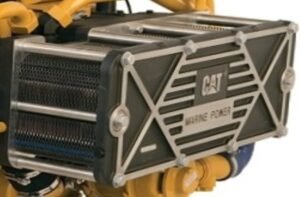
Cat C32 propulsion engines have been reigned in the marine industry since their market launch in 2020. These four-stroke V12 diesel combustion engines serve diverse applications across various industries. But at the heart of this internal combustion engine lies the revolutionary Caterpillar C32 Heatexchangers supported by a separate circuit after-cooling system (SCAC).
Caterpillar engines feature the best-in-class cooling systems for component safety, fuel efficiency, emission regulation, and extended equipment lifecycle. Read this exclusive guide to the Cat heat exchanger system in C32 engines to decide if these models are best for your vessel.
What is a Heat Exchanger in Marine Engines?
The heat exchanger is a valuable addition to marine engines to prevent overheating in the cylinders. This equipment regulates cooling by eliminating the heat from the lubricating fluids. The thermodynamic configuration in these machine parts accelerates the cooling process across hydraulic and engine oils.
Heat exchangers have a short lifespan due to the impact of heat, chemical, and salt corrosion. However, these can be replaced at a low cost without the need to upgrade to a new engine.
This is where the C32 engines gain popularity among vessel operators. The OEM Caterpillar C32 Heatexchangers are easily available for sale on eCommerce sites. Nevertheless, it is vital to purchase genuine parts from a trusted website.
Heat Exchanger Type and Design Used in Caterpillar C32 Engines
Caterpillar C32 engines (ACERT and non-ACERT versions) feature titanium plate heat exchangers operating on the shell and tube framework. Shell and tube heat exchangers commonly have a cylindrical shape sealed with plates on both sides.
This design comprises a shell compartment with a bundle of tubes for the primary fluid (cooling liquid). These tubes are connected to tube sheets on either end. The secondary fluid (hot oil) flows into the chamber through a valve and remains outside the tubes.
Benefits of Shell and Tube Heat Exchangers
There are several reasons for incorporating the shell and tube technology in engine cooling systems.
- The simple design of the internal chamber eases the repair and maintenance job.
- The robust framework of these heat exchangers offers greater resilience against corrosive substances.
- These are by far an economical cooling solution for generator sets, marine powering engines, and other applications.
- Reduced pressure dropping during the flow in the tube bundle protects the equipment from failure and heat transfer to the secondary fluid.
Cooling Technology in Cat C32 Heat Exchangers
The heat exchanger in C32 engines boasts an integrated air cooler for removing heat from the sides of the engine using seawater. There are additional attachments to support this cooling unit, including an anticorrosive treatment chamber. It treats the salt water to remove the corrosive chemicals and salt to prevent wear and tear of the engine casing.
The C32 version offers an option to integrate these thermostat machines into a seawater pump (mounted at the front end).
Do you want to purchase the original Caterpillar C32 parts?
Browse our intuitive web catalogue for Cat marine parts. You may place an order from the product page. If you do not see the required part number, feel free to contact us with the details.
Alfa Marine Spare Parts offers a massive stock of 80,000 Caterpillar products for various marine applications. We can supply engines and spare parts for your fleet in bulk quantities. From new engines and gensets to small Caterpillar electric parts, AMSP can supply anything to keep your vessel on the voyage without technical failures.
Our partnership with eminent shipping companies and trusted dealers worldwide facilitates fast and secure doorstep delivery.







